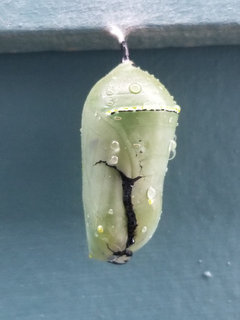This can't be good - black lines on Monarch chrysalis
weed30 St. Louis
5 years ago
last modified: 5 years ago
Featured Answer
Sort by:Oldest
Comments (24)
Iris S (SC, Zone 7b)
5 years agoweed30 St. Louis
5 years agolast modified: 5 years agoRelated Professionals
Elwood Landscape Architects & Landscape Designers · Fort Lee Landscape Architects & Landscape Designers · Ilchester Landscape Architects & Landscape Designers · Cicero Landscape Contractors · Madera Landscape Contractors · Pomona Landscape Contractors · Vacaville Landscape Contractors · Kingsburg Landscape Contractors · Carson Fence Contractors · Fort Lauderdale Fence Contractors · Holbrook Fence Contractors · Sioux City Fence Contractors · South Yarmouth Fence Contractors · Severna Park Fence Contractors · Sacramento Window ContractorsJay 6a Chicago
5 years agolast modified: 5 years agoweed30 St. Louis
5 years agoJay 6a Chicago
5 years agolast modified: 5 years agoIris S (SC, Zone 7b)
5 years agoweed30 St. Louis
5 years agolast modified: 5 years agoweed30 St. Louis
5 years agoIris S (SC, Zone 7b)
5 years agoHU-947571875
3 years agolast modified: 3 years agoMars SC Zone 8b Mars
3 years agorhizo_1 (North AL) zone 7
3 years agoMars SC Zone 8b Mars
3 years agoarchietexture
3 years agowoodrose
3 years agoNat Welch
2 years agolast modified: 2 years agoMason
2 years agoPam Henry
2 years agoarchietexture
2 years agoarchietexture
2 years agoarchietexture
2 years agoMaureen Vialard
last year
Related Stories

DECORATING GUIDESGet a Knack for Black
Black can make for rich interiors, but it can be intimidating. Have no fear — when used right, it's one of the best decorating colors around
Full Story
COLOR10 Pair-Ups for Black in the Kitchen
Combine black with other colors to add drama, polish and modernity. It also can make a kitchen look more spacious
Full Story
KITCHEN DESIGNThe Cure for Houzz Envy: Kitchen Touches Anyone Can Do
Take your kitchen up a notch even if it will never reach top-of-the-line, with these cheap and easy decorating ideas
Full Story
FEEL-GOOD HOMEThe Question That Can Make You Love Your Home More
Change your relationship with your house for the better by focusing on the answer to something designers often ask
Full Story
BATHROOM DESIGNWhite Toilet, Black Lid: Trending in a Bathroom Near You
Contrast is king with this look for the bath — and it works with any style you can think of
Full Story
BATHROOM DESIGN10 Bathrooms That Look Great in Black
Crisp white is often the starting point for a bathroom design, but going to the dark side can reap stylish rewards
Full Story
DINING ROOMSNew This Week: These Dining Rooms Know How to Have a Good Time
You can add some fun to your room decor, whether your taste is traditional, contemporary or something in between
Full Story
ROOM OF THE DAYMaster Bathroom With Clean Lines and a Calming Vibe
Designers use concrete, wood and matte black to create a restful space for a Pennsylvania couple
Full Story
LANDSCAPE DESIGNGet a Knack for Black in the Garden
Dark walls, furniture and foliage do more than add drama in the landscape; they can be strategic design elements
Full Story
FEEL-GOOD HOMEFeel-Good Home: Water, Water, Everywhere
You can mindfully introduce water features into your landscape no matter the size of your yard
Full Story











weed30 St. LouisOriginal Author